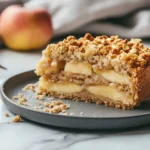I’ve always had a soft spot for warm, cozy desserts. There’s something about a bubbling fruit filling topped with a golden, buttery crust that feels like home. But let’s talk about the real star of the show—the dough. What is cobbler dough made of? If you’ve ever wondered how this magical topping comes together, you’re in for a treat.
Unlike pie crust, which is rolled out and carefully placed over a filling, cobbler dough is much more forgiving. It’s soft, rustic, and spooned or dropped on top, creating that signature, uneven texture that bakes up beautifully crisp outside and tender on the inside. Whether you like your biscuit-like or more cake-like, there’s a cobbler dough style for everyone.

Why Cobbler Dough Is So Special
Cobbler dough is simple yet magical. It bakes up golden, crisp on top and soft underneath, soaking up all that delicious fruit filling. Unlike pie crust, it’s rustic, easy to make, and forgiving, making it a go-to for home bakers.
The best part? No rolling, chilling, or precise shaping is required. Just mix, drop, and bake! Whether you love a buttery biscuit-style cobbler or a light, cake-like version, the dough makes this dessert unique.

Key Ingredients for Cobbler Dough
Making cobbler dough is super simple. I bet you have most of these ingredients in your kitchen already!
1. Flour
The base of cobbler dough. All-purpose flour works perfectly, but you can swap whole wheat flour or a gluten-free blend for a heartier texture.
2. Sugar
A little bit of granulated sugar adds just the right amount of sweetness. If you’re making a savory cobbler (yes, that’s a thing!), you can skip this or use brown sugar for a deeper flavor.
3. Baking Powder
This is what gives the dough its light, airy texture. Without it, your cobbler topping might turn out dense instead of fluffy.
4. Butter
Here’s where the magic happens. Cold butter is key for a flaky texture. If you want extra richness, go for salted butter. For a dairy-free option, coconut oil or plant-based butter works too.
5. Milk or Cream
You need liquid to bring the dough together. Whole milk makes the dough tender, but you can also use heavy cream for an extra indulgent bite. Almond or oat milk works if you’re dairy-free.
6. Salt
A pinch of salt enhances the taste and balances the sweetness. If you’re using salted butter, reduce the added salt slightly.
7. Optional Add-Ins
Want to make your cobbler dough stand out? Try:
- Cinnamon or nutmeg for a warm spice kick
- Vanilla extract for a hint of sweetness
- Chopped nuts for crunch

How to Make Cobbler Dough
This is where the fun begins! Making cobbler dough is incredibly easy—follow these steps:
1. Mix the Dry Ingredients
Whisk together the flour, sugar, baking powder, and salt in a large bowl. This step is essential to ensure all the ingredients are mixed nicely so that the dough bakes up evenly and comes out just right.
2. Cut in the Butter
Work the cold butter into the flour mixture using a pastry cutter or your fingers until it looks like coarse crumbs. The little bits of butter will melt as the cobbler bakes, creating a light, flaky texture.
3. Add the Liquid
Slowly pour the milk (or cream) and stir gently until the dough comes together. Be careful not to overmix! Overworked dough may become tough instead o tender.
4. Spoon or Drop the Dough Over the Filling
Instead of rolling it out, spoon or drop dough dollops over your fruit filling. It doesn’t need to be perfect—cobbler is meant to be rustic!
5. Bake Until Golden Brown
Pop your cobbler into a 375°F oven and bake for 30-40 minutes, until the topping is golden golden and the fruit bubbles around the edges.
If you’re curious about a shortcut version, check out this easy Cake Mix Cobbler Recipe. It simplifies the process while maintaining all the delicious flavors.
Pro Tips for the Best Cobbler Dough
Use cold butter – This keeps the dough light and flaky.
Don’t overmix – A few lumps are okay! Overmixing makes the dough tough.
Let it rest – If you have time, let the dough sit for 5-10 minutes before baking. This helps the flavors meld.
Experiment with flavors—add spices, citrus zest, or even a splash of bourbon for a fun twist!
Chef’s Tips & Variations for Cobbler Dough
Now that you know how to make cobbler dough from scratch, let’s discuss ways to tweak and customize it to fit your preferences. Whether you want a healthier version, a gluten-free option, or just some extra flair, here are my best tips!
1. Experiment with Different Flours
While all-purpose flour is the go-to choice, you can switch things up:
- Whole wheat flour – Adds a hearty, nutty flavor and extra fiber.
- Gluten-free flour blend – Works well for those avoiding gluten. Look for a 1:1 baking blend.
- Almond flour is a low–carb option, but it creates a denser texture. Try mixing it with a gluten-free blend for better results.
2. Make It Dairy-Free
If you’re avoiding dairy, don’t worry—you can still enjoy a delicious cobbler topping!
- Swap vegan butter or coconut oil for vegan butter.
- Use almond, oat, or soy milk instead of regular milk.
3. Add a Flavor Boost
Want to take your cobbler dough to the next level? Try these fun add-ins:
- Cinnamon & nutmeg – Adds warmth and spice.
- Lemon or orange zest – A little citrus zest brightens up the flavor.
- Brown sugar instead of white – Creates a more profound, caramel-like sweetness.
- Chopped nuts (pecans, walnuts, or almonds) – Adds crunch and texture.
4. Adjust the Sweetness
Not a fan of overly sweet desserts? No problem!
- Reduce the sugar if your fruit filling is already sweet.
- Try honey or maple syrup instead of granulated sugar for a natural sweetness.
How to Keep Cobbler Fresh
Cobbler tastes best fresh out of the oven, but here’s how to store it properly:
- Same Day: Cover loosely with foil and keep at room temperature.
- Refrigerate (Up to 4 Days): Store in an airtight container once cooled.
- Reheat for Best Texture:
Oven: 350°F for 10-15 minutes (keeps it crisp).
Microwave: 30-45 seconds (may soften topping). - Freeze for Later: Assemble and freeze before baking (up to 3 months) or freeze-bake a cobbler (up to 2 months).
For the best flavor and texture, always reheat in the oven!
1. Can I use self-rising flour for cobbler dough?
Yes! Self-rising flour already contains baking powder and salt so that you can skip those ingredients in the recipe.
2. Why is my cobbler dough too dry?
The dough may need more liquid if it feels too dry or crumbly. Add one tablespoon of milk until the mixture forms a cohesive dough. Be careful not to overwork it!
3. Can I make cobbler dough ahead of time?
Absolutely! You can mix the dry ingredients and cut in the butter beforehand. Store it in the fridge for up to 3 days, then add the liquid when ready to bake.

Creative Ways to Use Cobbler Dough
Cobbler dough isn’t just for fruit cobblers! Try these fun variations:
- Savory Cobbler: Add cheese and herbs for a savory chicken or veggie cobbler.
- Mini Cobbler Muffins: Bake individual servings in muffin tins.
- Cobbler Pancakes: Thin the dough and cook as fluffy pancakes.
- Stuffed Pastries: Fill with fruit jam or chocolate for a quick treat.
- Cinnamon Roll Cobbler: Add cinnamon sugar for easy cinnamon rolls.
This dough is versatile, simple, and delicious in so many ways!
For another comforting, fruit-filled dessert, you might enjoy this Apple Crumble Cake, which offers a slightly different texture but the same cozy, homemade feel.
Conclusion
So, what is cobbler dough made of? It’s a simple, rustic mixture of flour, butter, sugar, baking powder, and milk—but the magic is how you make it your own. Whether you prefer a biscuit-style topping or a softer, cake-like version, cobbler dough is one of the most effortless and versatile baking staples.
The best part? You don’t need to be a pro baker to make a perfect cobbler. With just a few pantry staples and some creativity, you can whip up a delicious dessert that’s cozy, comforting, and crowd-pleasing.
Now it’s your turn! What’s your favorite way to make a cobbler? Try out this dough recipe and let me know how it turns out. Happy baking!
Print
What is Cobbler Dough Made Of?
- Total Time: 45 minutes
- Yield: 6-8 servings 1x
- Diet: Vegetarian
Description
Cobbler dough is a warm, buttery topping that pairs perfectly with a bubbling fruit filling. It’s simple to make, requires no rolling, and bakes up golden and crisp while staying soft inside. This easy recipe is versatile and delicious whether you prefer a biscuit-style or cake-like texture.
Ingredients
Dry Ingredients for Cobbler Dough
- 2 cups all-purpose flour (swap with whole wheat or gluten-free flour if needed)
- ¼ cup granulated sugar (or use brown sugar for a richer flavor)
- 1 tablespoon baking powder (helps create a light, airy texture)
- ½ teaspoon salt (enhances overall flavor)
Wet Ingredients for Cobbler Dough
- ½ cup unsalted butter, cold and cubed (or substitute with coconut oil for a dairy-free option)
- ¾ cup whole milk (almond or oat milk works well as dairy-free alternatives)
- 1 teaspoon vanilla extract (optional, but adds a lovely aroma and sweetness)
Optional Add-Ins for Cobbler Dough
- ½ teaspoon cinnamon or nutmeg (adds warmth and depth of flavor)
- 1 tablespoon lemon zest (brightens the dough with a hint of citrus)
- ¼ cup chopped nuts (for a slight crunch in every bite)
Instructions
Combine the Dry Ingredients
Start by whisking the flour, sugar, baking powder, and salt in a large mixing bowl. This ensures all the ingredients are evenly distributed, setting the stage for a perfectly balanced dough.Work in the Butter
Next, add the cold butter cubes to the flour mixture. Blend the butter into the dry ingredients using a pastry cutter or your fingertips until the mixture resembles coarse crumbs. These small butter pockets will melt during baking, creating a soft and flaky texture.Incorporate the Liquid Ingredients
Slowly pour in the milk and vanilla extract while stirring gently. Be careful not to overmix—the dough should come together with a slightly shaggy texture. Overworking it can lead to a dense, chewy consistency rather than a light, tender bite.Portion the Dough Over the Filling
If you’re using this dough for a cobbler, spoon or drop small portions over your prepared fruit filling. There’s no need to spread it out evenly—letting it remain rustic will create that beautiful golden, textured topping when baked.Bake Until Perfectly Golden
Finally, preheat your oven to 375°F (190°C) and bake for 30-40 minutes. You’ll know it’s ready when the top is golden brown and crisp and the dough is cooked. Serve warm and enjoy!
Notes
- Keep the Butter Cold – Cold butter is essential for a flaky, biscuit-like texture. Avoid softening it before use.
- Mix Gently – Stir just enough to bring the dough together. Overmixing will result in a tougher texture.
- Customize the Flavor—To enhance the taste, Add spices, citrus zest, or even a splash of vanilla.
- Dairy-Free Alternative – Substitute butter with coconut oil and use plant-based milk for a dairy-free version.
- Prep Time: 10 minutes
- Cook Time: 35 minutes
- Category: Dessert
- Method: Baking
- Cuisine: American
Nutrition
- Serving Size: 1 portion
- Calories: 220
- Sugar: 12g
- Sodium: 150mg
- Fat: 10g
- Saturated Fat: 5g
- Unsaturated Fat: 3g
- Trans Fat: 0g
- Carbohydrates: 30g
- Fiber: 2g
- Protein: 2g
- Cholesterol: 30mg



